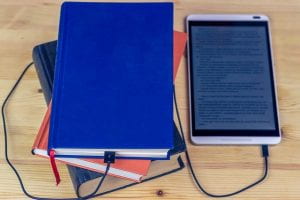
I have chosen to study this elective as I know my knowledge in this area is lacking. I acknowledge the rise in technology and along with it, the eBook but I have in no way made the most of the opportunities it affords my students in the classroom, or now in the library.
Personally, I am a physical book kind of girl. The joy I get from holding the book, especially when design features such as textured or embossed covers, thick pages etc. as well as the smell is very real. Jabar (2013) shows that I am not alone in this and also brought to my attention another feel good function of the physical book, “Turning the pages of a paper book is like leaving one footprint after another on the trail—there’s a rhythm to it and a visible record of how far one has traveled”, and how far one has to go.
However, whilst this may be my (and many others) experience for now, this nostalgia for the physical book may not be present in young and future generations and there is no question we, as educators, need to be upskilling students in the new types of literacy needed to keep up with technology (Sadokierski, 2013). Unfortunately it seems that technology and digital literacy is still taught as an ‘extra’ rather than fully integrated into classroom lessons.
Of course the digital divide also presents many challenges with fully implementing this, as has been made evident during the COVID-19 induced home learning situation. While not all families may be able to afford to buy books for the family, the public and school library services mean that there is no reason for students to miss out on experiencing a book, it is totally free to borrow. When these services were taken away (physical borrowing) students who did not have access to a suitable device and/or internet were left without books. The biggest problem with digital literature is that a device of some sort, and access to charge, is required. On top of that, there appears to be a lack of consistent file type, with your device determining the one you will require (Sadokierski, 2013). As a physical book lover, this is one area I have limited experience with.
A final challenge for educators is determining what actually qualifies as digital literature (Lamb, 2011; Sadokierski, 2013). Some eBooks are merely the same content as the physical book, with the only real difference the format. Others are enhanced with interactive features such as animation, links to maps, websites and more. While I have introduced eBooks to our library collection this year, the subscription is really of the former material and again, through this subject, I hope to gain knowledge and experience in regard to the latter.
References
Jabr, F. (2013). The reading brain in the digital age: The science of paper versus screens. Scientific American, April 11. Retrieved from: http://www.scientificamerican.com/article/reading-paper-screens/
Lamb, A. (2011). Reading redefined for a transmedia universe. Learning and Leading with Technology, 39(3), 12-17. Retrieved from http://ezproxy.csu.edu.au/login?url=http://search.ebscohost.com/login.aspx?direct=true&db=ehh&AN=67371172&site=ehost-live
Sadokierski, Z. (2013, November 12). What is a book in the digital age? [Web log post]. Retrived from http://theconversation.com/what-is-a-book-in-the-digital-age-19071
